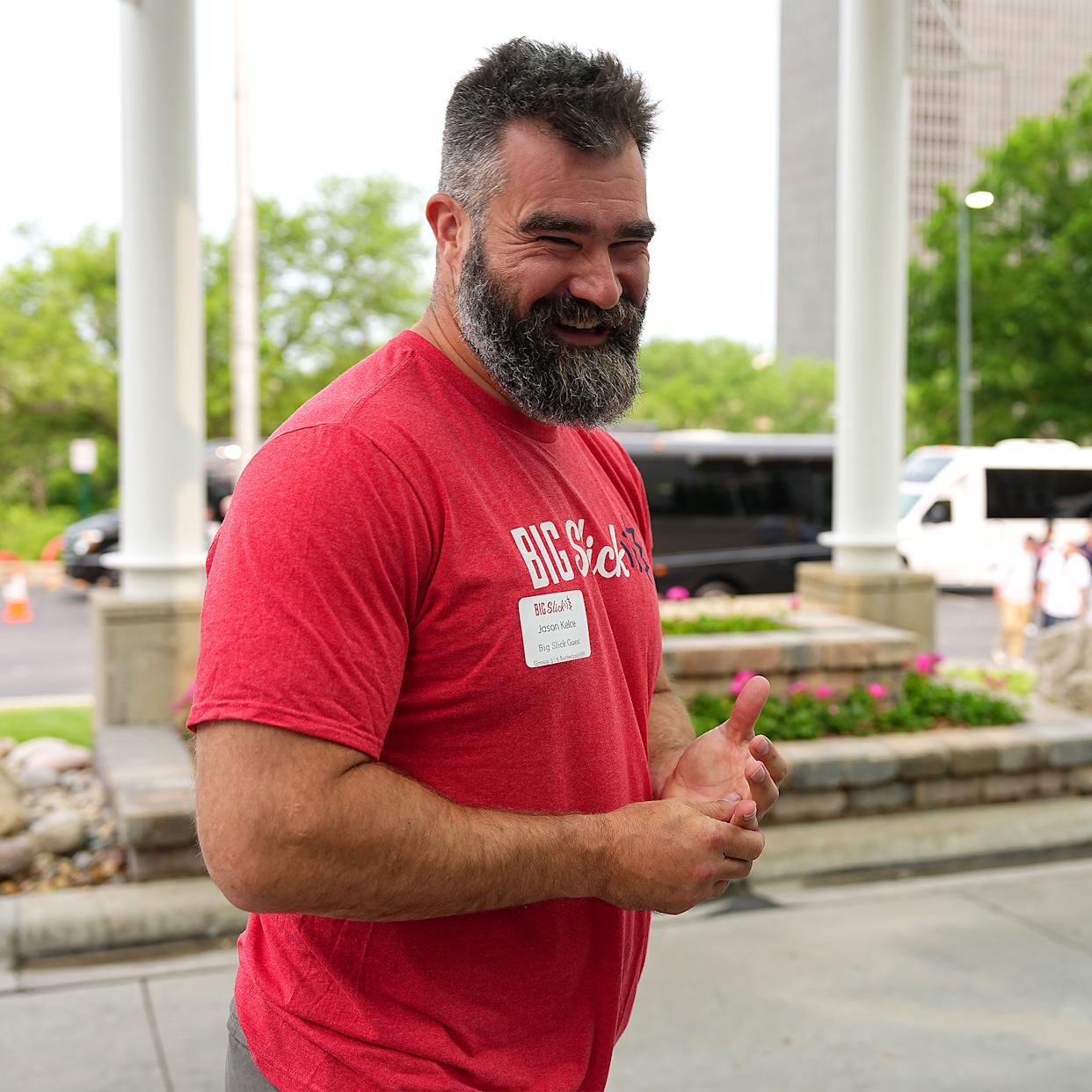Picture this: A few months after hanging up his pads, Jason Kelce stands in front of a mirror wearing an old Eagles jersey. It fits differently now — looser, lighter — and he can’t help but grin. For the first time in over a decade, his body doesn’t feel like a machine built to take hits. It feels like his again.
For years, Jason Kelce’s frame — nearly 300 pounds of strength and grit — was his armor on the football field. As a Super Bowl–winning center, every pound mattered. But once he retired, the game was over, and the rules changed. His body didn’t need to be built for impact anymore. It needed to be built for life — for chasing his daughters around, sleeping without back pain, and feeling genuinely good.
This isn’t just another “celebrity lost weight” story. It’s about a man redefining himself after years of extreme physical demand — and finding health not through fads or obsession, but through simplicity, self-awareness, and purpose.

From Bulking Beast to Balanced Dad
The NFL mentality
For over 13 seasons, Jason’s mission was to be as strong and immovable as possible. That meant eating thousands of calories daily, maintaining muscle mass, and carrying close to 300 lbs to stand firm against 300-lb defensive linemen. His body was a fortress — and a job requirement.
When he retired, that fortress became extra baggage. The first realization came quietly: climbing stairs felt harder than it should, his knees ached more often, and playing with his kids wasn’t as easy as expected. He didn’t need to be a wall anymore. He needed to be mobile, energized, and present.
The mindset shift
The moment he decided to lose weight wasn’t about image. It was about function — feeling lighter on his feet, improving his longevity, and being able to do everyday things without pain. That kind of motivation sticks because it’s rooted in purpose, not vanity.
Lesson: If your “why” goes beyond appearance — if it’s about energy, family, or living better — you’ll find it much easier to stay consistent.
Strategic Simplicity: No Fads, Just Fundamentals
No extremes
Jason didn’t dive into the latest trend. No keto, no vegan overhaul, no miracle detox. Instead, he focused on something basic but powerful: awareness. He started tracking his calories and paying attention to how much energy he was actually consuming versus burning.
He didn’t starve himself or ban favorite foods. Instead, he reduced portion sizes and adjusted his overall intake. The secret wasn’t deprivation — it was moderation.
Protein as the anchor
Jason emphasized maintaining his protein intake while cutting calories. That’s a critical move: when losing weight, the body tends to burn muscle alongside fat unless it’s given enough protein and resistance training stimulus. Preserving muscle mass keeps metabolism high and ensures the body remains strong and functional.
Scientific takeaway:
-
Weight loss occurs in a calorie deficit.
-
Adequate protein (~1.6–2.2 g/kg of body weight) protects muscle tissue.
-
Moderate calorie reduction (300–500 kcal/day) beats extreme dieting every time.
What makes this unique
Jason’s story stands out because of how simple his approach was. In a world obsessed with gimmicks, he trusted consistency, not extremes. It’s proof that the fundamentals — tracking, protein, and patience — still work better than any trend.
Training Smarter: Respecting His Body’s Limits
The cost of a 13-year career
Years of professional football left their mark — on Jason’s joints, back, and ankles. Instead of pushing through pain like he once did, he learned to adapt. That’s what separates an athlete from a sustainable fitness enthusiast: knowing when to push and when to pivot.
Smarter workouts, not harder ones
He structured his workouts into “blocks”:
-
Hypertrophy blocks (building and maintaining muscle)
-
Explosive movement phases (keeping athleticism and coordination)
-
Strength cycles (heavy but joint-friendly lifting)
He replaced high-impact drills with low-impact alternatives — like running on grass, cycling, and mobility training.
The overlooked principle
For many, injury or joint pain becomes an excuse to stop. Jason turned it into an opportunity to evolve. He learned that effective fitness isn’t about intensity — it’s about adaptation.
Lesson: If your body hurts, it’s not a signal to quit — it’s a signal to adjust. Sustainable training respects your limits while improving your capabilities.
Mindset Over Muscle: Redefining Identity
Letting go of the “big guy” label
For someone who built a career around being massive and powerful, losing size isn’t just physical — it’s psychological. Jason admitted that seeing his smaller frame felt strange, even “a little depressing.” It reminded him of how much his life had changed.
But soon, that discomfort turned into clarity. He realized his value wasn’t tied to his size — it was tied to how he lived, how he felt, and how present he could be for his family.
The emotional honesty
That vulnerability — admitting that transformation can feel bittersweet — makes his story real. Many people struggle with identity when losing weight: the fear of becoming someone new. Jason embraced it, showing that strength is as much emotional as it is physical.
Lesson: Transformation isn’t just about what you lose. It’s about what you gain — freedom, confidence, and connection to your real self.
Family, Work, and Life Balance
Real-world chaos
Between broadcasting, podcasting, and parenting four kids, Jason’s schedule is chaos. Yet he still finds time for health. The key? He doesn’t aim for perfection — just consistency.
He’s said he enjoys small indulgences — even donuts or cake now and then. Instead of guilt, he practices balance. It’s a mindset shift from “I failed” to “I’ll do better tomorrow.”
How he makes it work
-
Flexible routines: Shorter, more efficient workouts instead of two-hour gym marathons.
-
Food awareness: Knowing portion sizes and adjusting throughout the week.
-
Family involvement: Turning active play and outdoor time into movement opportunities.
What readers can take away
Most people struggle not because they lack discipline, but because they chase perfection. Jason’s lifestyle shows that imperfect consistency beats short-term intensity every time.
Tip: Choose two realistic habits — like walking daily or tracking meals on weekdays — and do them well. You don’t need a perfect plan. You just need a doable one.

The Science of Function, Not Just Fat Loss
Beyond the scale
When Jason dropped 20–30 lbs, something more important happened: his knees hurt less, his back felt stronger, and his energy skyrocketed. That’s the kind of “before and after” that actually matters.
Instead of obsessing over numbers, he focused on functional improvements — how his body performed in real life.
The biological benefits
-
Joint relief: Every pound lost reduces knee joint stress by roughly four pounds of pressure.
-
Better sleep: Weight reduction can improve sleep apnea and recovery.
-
Reduced inflammation: Lower fat mass reduces chronic inflammation, benefiting long-term heart and metabolic health.
-
Improved mobility: Less mass means better coordination, faster reaction time, and less fatigue.
A refreshing perspective
Jason didn’t chase “shredded abs” or celebrity aesthetics. He chased longevity. That’s a rare and refreshing take in an image-driven culture — and one that’s far more sustainable for everyday people.
Lesson: Focus on how your body functions, not just how it looks. Health is performance, not perfection.
Sustainability: The Secret Ingredient
The power of patience
Jason’s results didn’t come overnight — they came from small, consistent choices stacked over time. That’s what makes them sustainable.
He didn’t overhaul his life in a week. He replaced one habit at a time: tracking food, prioritizing protein, improving sleep, adjusting workouts. Those micro-changes compound into macro results.
Why most people fail — and how he didn’t
Most dieters fail because they chase speed, not sustainability. Jason’s slow-burn approach kept his metabolism healthy, his muscle intact, and his mental game strong.
Practical tip:
-
Make one small change each week (e.g., drink more water, sleep 30 min earlier).
-
Stick to it until it’s automatic.
-
Then add another.
That’s how lasting transformations are built — quietly, consistently, and patiently.
What His Story Teaches Us About Ourselves
Jason Kelce’s transformation goes beyond diet and exercise. It’s a story of transition — from athlete to father, from competitor to caretaker, from performance to wellness.
For the everyday person, his journey offers three powerful lessons:
-
Purpose beats perfection. Find a reason that matters deeply — health, family, freedom — and let it guide you.
-
Muscle is your ally. Prioritize strength and protein, not starvation.
-
Consistency is the magic. You don’t need a new plan every month — you need to stay with the one that works.
Jason’s 30-lb loss isn’t the main achievement. It’s the byproduct of a bigger victory: learning how to live well outside of competition, and proving that true strength is measured by how you care for yourself and others.
FAQ
Q1: How much weight did Jason Kelce lose? He lost around 20–30 pounds after retiring from the NFL.
Q2: Did he follow a special diet like keto or vegan? No. He simply tracked calories and ate a balanced, moderate diet.
Q3: How did he keep muscle while losing fat? He maintained high protein intake and continued strength training.
Q4: What workouts did he use? He followed periodized training blocks combining muscle work, strength, and mobility.
Q5: Why did he decide to lose weight? To reduce back and knee pain, increase energy, and stay active with his kids.
Q6: What’s his current goal weight? He’s aiming for around 250–260 lbs — strong but healthier.
Q7: What can we learn from his experience? That small, consistent habits built around real life lead to lasting results.
Q8: Was it emotionally difficult for him? Yes — he admitted that losing size felt strange at first, but ultimately freeing.
Conclusion
Jason Kelce’s weight loss isn’t a story about cutting carbs or chasing perfection. It’s a story about rediscovering balance, purpose, and identity after years of physical intensity.
His approach — rooted in simplicity, science, and self-awareness — reminds us that transformation isn’t about extremes. It’s about understanding your body, respecting your limits, and making steady, meaningful progress.
If there’s one lesson to carry forward, it’s this: start small, stay consistent, and anchor your goals in what truly matters. Whether it’s 5 lbs or 50 lbs, change begins the same way — with one intentional step toward a healthier, happier you.
Start today. Track one meal. Take one short walk. Reconnect with your “why.” Like Jason Kelce, you’ll soon discover that real strength begins not with how much you can lift — but with how well you can live.